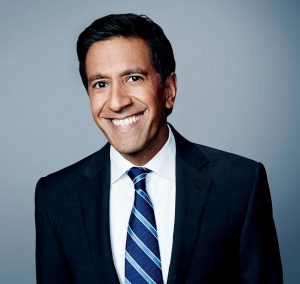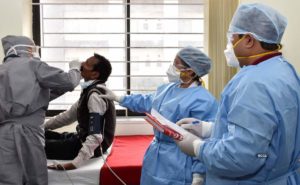Corona cases may increase after lockdown is lifted says Dr. Sanjay Gupta, CNN’s Chief Medical Correspondent. In an exclusive interview Dr. Sanjay Gupta talks about how the world is fighting the corona virus infection and says he is surprised by India’s numbers.


With the number of cases in USA over a million now and more than 68,000 people dead. In hindsight, do you reckon that the US could have done anything differently?
Yes, I think it’s always difficult to look backwards and try and analyse the decisions but I think that like many places around the world, we should have acted more quickly. This was a new virus, we know that it was a very contagious virus that was circulating and spreading around the world. That was very clear. I think one thing that wasn’t clear was how was this going to behave. A lot of people immediately thought that this was going to be like SARS back from 2003. At that time it was a lot of worry but it didn’t end up being that contagious. About 8000 people around the world were affected by this, 800 people died. So, very high fatality rate – 10% but not very contagious. I think there was just bits of information that were starting to come out about this at the time and people weren’t quite sure how this virus is going to behave. However, even if you take that into consideration, it wasn’t until the middle of March in the United States where we started to advise people to stay at home. That was maybe a month or even six weeks after we knew probably enough to make these types of recommendations.
We are at a stage where we have been in some form of a lockdown from the last couple of months or so and we are looking at easing up on the lockdown. From a medical perspective, could you outline the risks involved in opening up too fast?
I am a doctor and also a citizen, I want things to ease up in terms of the lockdown. But this is a virus that is still out there. No matter when you start to open things up, you are going to see an increase in infections. That is the truth. The question is how much you are willing to tolerate in terms of the increase in infections. Are you going to be able to handle it in terms of the hospitals? The critical component everybody is talking about around the world is you have to able to test very quickly, find somebody who has the virus, isolate them and find the contacts. That’s how you start to contain it to essentially put the virus inside the box, right now the virus is spreading freely. If you can put it inside the box, I think we can start to open up but we don’t have the capacity in the US to do that. We aren’t testing enough right now. To be fair, most places around the world have had challenges. For some period of time, we are going to have very confident and widely available testing.
That’s one of the issues we are having in India as well with the rate of testing. I am not sure how much you are following the case curve in India, with 43,000 cases and more than 1300 deaths. Has India surprised you on the upside, just by the numbers alone?


There is an unanswered question in terms of how much climate plays the role. Even in the US, some of the southern states where the weather has been warmer and more humid. So far we have not seen a significant exponential growth as we saw in some of the cooler and drier climates. Often times we see some seasonal variations in these types of viruses and maybe that’s playing a role in India as well. I think India has to be prepared as once the growth occurs, it doesn’t grow linearly at that point day to day by the same number. It can suddenly take off and people will have to be prepared for that.
It’s interesting that you are referring to the climate factor and we will have to have more research to find out if climate did indeed play a role. I also want you to talk to us about the potential race to find the vaccine. There are a half a dozen methods around the world, I am curious what you think of these efforts and which of these look more promising to you in terms of which one can hit the market the soonest?
First of all, it can take typically 10 years to create a vaccine. We are talking about 1 year which is already a very rapid timescale. Secondly, you are giving a little piece of the virus and causing the body to develop an immune response and learn how to defend itself against this virus if it’s exposed again. That’s how vaccine typically works. The type of vaccines we are hearing in several of the trials are entirely different vaccines, they are basically just looking at a little piece of genetic material for a component of the virus. It’s a genetic vaccine. This has never been done before. It’s been tried when they were working on SARS vaccine in the past so that they could build on some of the knowledge. If it works, it should be a safer vaccine, easier to scale or produce because you are basing it on this genetic material. We have to go through the trials to make sure it actually works. I think it’s optimistic but some of the big companies are saying that even by the fall they may have evidence that it works. This virus is contagious, it can spread around the world quickly. So, we have to make sure that whenever the vaccine is available, it’s made available to everybody otherwise it won’t have the desired outcome.
I’m sure you’re following different countries and the way they are responding to Covid-19. I want you to comment on two things – one, which of the countries that you find having most successfully dealt with Covid-19 and what’s perhaps the reason behind that success and also we had the Chief Epidemiologist of Sweden last week here on the program and they of course, as you know, have a completely different strategy in dealing with Covid-19 and with some success. So,I was wondering if you could care to comment on both.
Well, you know,with the first question it’s a little bit hard to pit one country against the other as you know there are so many different factors that go into why a country has success in terms of the underlying health care system, their having dealt with similar sorts of outbreaks in the past but I think if you look across the board South Korea is one of the countries people often point to and I think there are a couple of primary reasons– one, they acted quickly in terms of testing. That is the key. I mean if you can test and then act upon that testing – isolate people and then trace their contacts, you could start to really box this virus in. I know it sounds very rudimentary. We like to talk in terms of big new therapeutics and vaccines and things but that is the strategy that we’re talking about, what has worked for previous outbreaks and they applied it quickly. I think it’s a question of not only doing and applying the strategy but doing it right away. If you look at overall positivity rate, meaning, if they test a hundred people,how many people would come back positive. It’s about two people so about two percent positivity rate. That typically means you’re testing enough people. You want that number to be under 10 percent. In the United States, for example, where I am closer to 18 percent that means we’re not testing enough. So we’re still catching up here in the United States.













